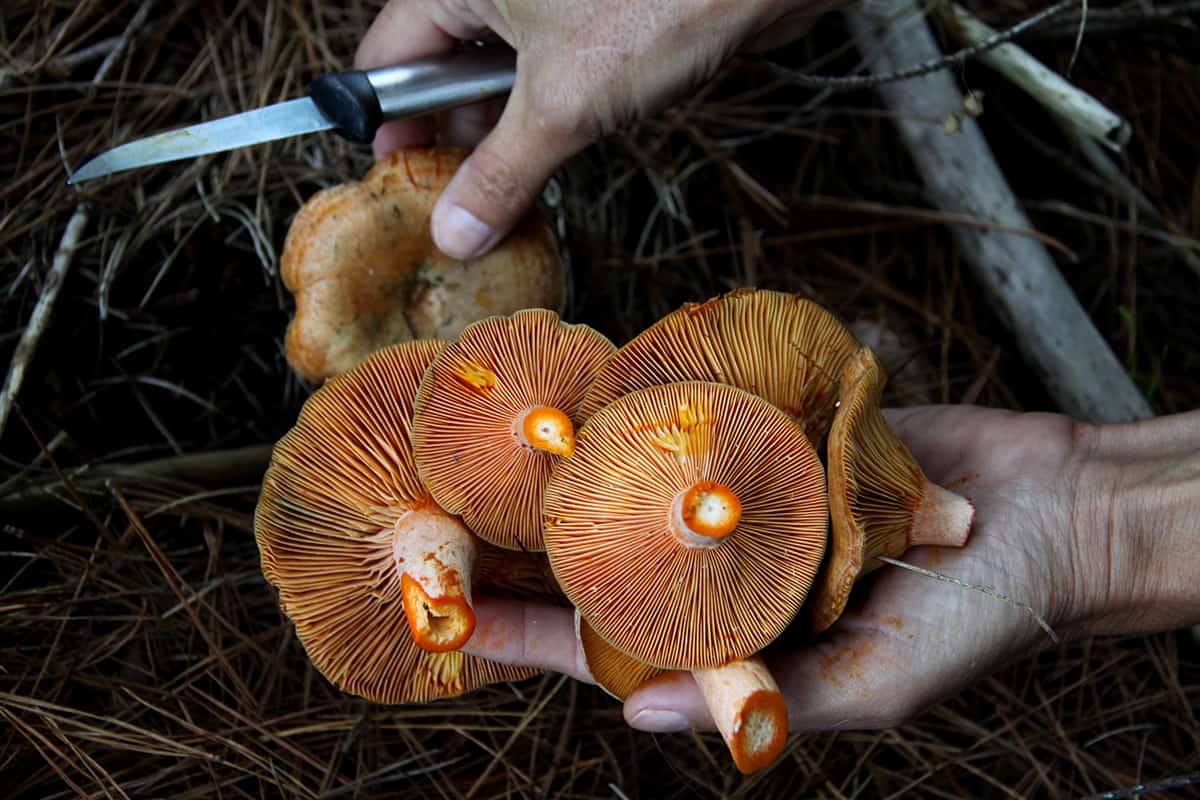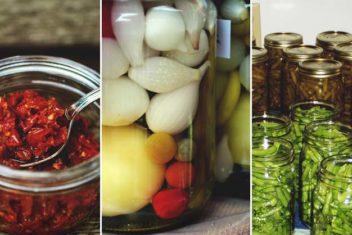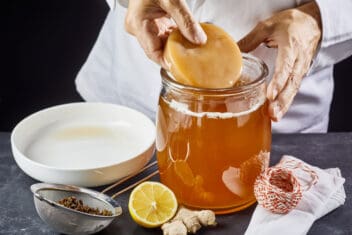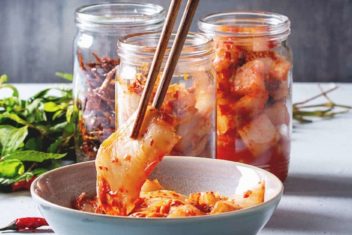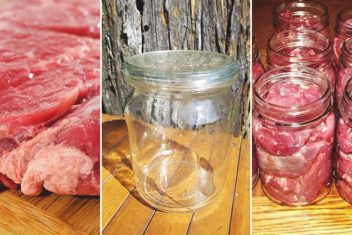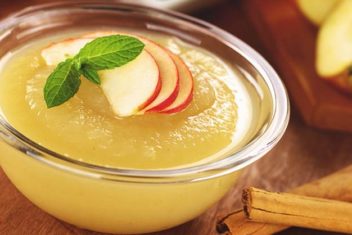Mushroom foraging is a fantastic hobby that can even earn you money. Not only are foraged mushrooms delicious, but they sell for high prices. Plus, you can supplement your diet with some healthy (and free!) veggies.
The downside is that getting mushroom foraging wrong can be deadly. Seriously. Some wild-grown mushrooms are poisonous. That’s why it’s crucial to learn which mushrooms are safe to eat.
We’re going to cover what you need to know to get started with mushroom foraging in this easy to understand guide.
7 Essential Tips for Mushroom Foraging
I’m sure you’re eager to jump in, but there are some important tips to note before you head out into the woods to look for wild mushrooms.
1. Use Apps & Books
There are apps out there, such as Wild Edibles, that help you learn which mushrooms are safe to forage and eat and which are not. If you aren’t an app type of person, grab a few books, and bring them with you into the woods.
2. Cut – Don’t Pull
Cut the mushrooms rather than pulling them up by the roots. Pulling up the roots stops them from regrowing. Cut mushrooms will come back next year.
3. Take Only What You Need
An important part of sustainable mushroom foraging is to only take what you plan to eat. Mushrooms can be preserved, and if you know that you WILL eat them, then it’s okay to take them.
However, try to pluck them only a handful at a time to give the mushrooms time to regrow.
4. Take Pictures and Ask Questions
Join a few mushroom foraging groups on social media that let you post pictures for identification.
Then if you come across a mushroom that you don’t recognize and don’t want to pick, use your phone to take a picture.
Utilizing the knwoldge of more experienced foragers is part of mushroom hunting.
5. Forage After a Heavy Rain
Mushrooms love moist, damp, humid conditions, and the best time to find those conditions in the woods is after a heavy rain. They grow like crazy after heavy rains, especially if there was a dry spell beforehand.
6. Know the Most Common Places to Find Mushrooms
The hardest part of foraging for mushrooms is finding them. But each mushroom type has a few requirements for where they’ll grow. Here are some places to look for wild mushrooms.
- Look for downed logs or stumps because some mushrooms love decaying matter.
- Check around tree trunks and the root area for varieties that prefer those places.
- Burned parts of the forests or fields are a serious honey hole for mushroom foraging. Mushrooms take over burnt areas.
- Loamy soil is a mixture of sand, clay, and organic matter, and many varieties love loamy soil.
- Check along streams and creeks, which often contain tons of mushrooms due to the high moisture content.
7. Get to Know the Dangerous Mushrooms
Yes, you should definitely learn how to identify the good ones, but you should also make sure you can spot the inedible mushrooms.

Once you’ve learned what a death cap mushroom looks like, you’ll never mistake it for something edible.
Edible Mushrooms You Can Forage
It’s believed that there are over 10,000 species of fungi that grow mushrooms, but only around 30 types of mushrooms are edible. That means it’s essential to know which mushrooms you can eat and which ones you cannot.
Here are some of the most common types of edible mushrooms you can forage.
1. Puffball Mushrooms
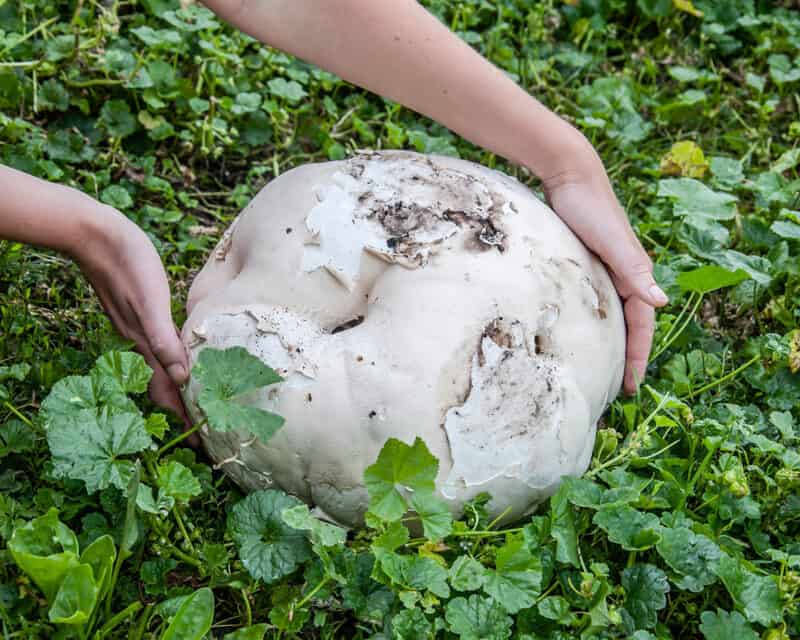
One of the easiest mushrooms to identify are puffballs. They’re spongy with a marshmallow-like texture. Giant puffballs measure between four to 12 inches or more, making them easy to pick out in the woods.
Most puffballs are white or off-white and rounded; you won’t find any visible stems or gills. Make sure you check this before eating. Cut it in half, top to bottom, and make sure the flesh is consistently white and uniform without any internal structures.
If it fits those requirements, it’s edible. Puffballs have an earthy flavor, and they’re quite versatile for culinary purposes.
It’s best to research the different types of puffball mushrooms and ask other mushroom foragers what varieties grow most often in your area. There are dozens of varieties, some edible, some not.
2. Chanterelles Mushrooms
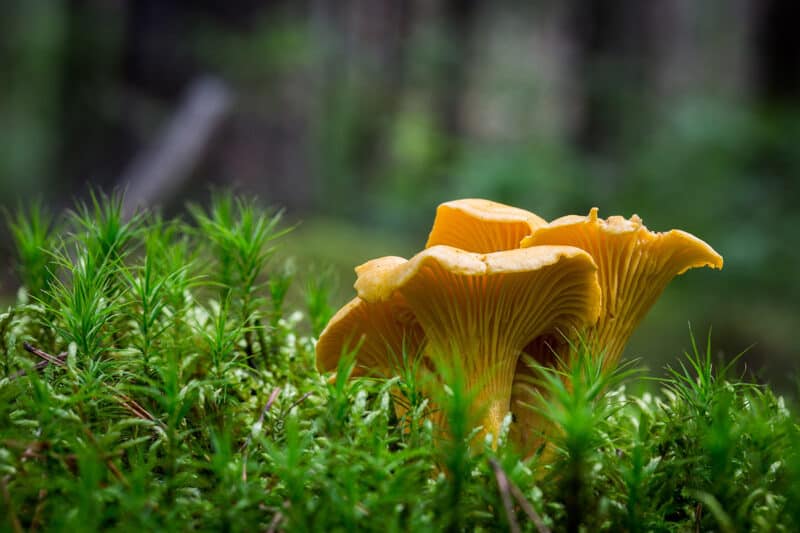
One of the most desired mushrooms are chanterelles. They’re easy for beginners to identify due to their bright colors, ranging from pale orange-yellow to bright gold. Chanterelles stand out in the forest, and they’re easy to distinguish compared to their poisonous look-alike.
Remember, true chanterelles have false gills that are not easily separable. They also have a smell similar to apricots.
Chanterelle mushrooms love to grow under oak trees in the fall leaves. However, if you find the mushroom growing on fallen wood, it’s not chanterelle. They tend to grow in clusters, so if you find one, keep searching for more.
False chanterelles look similar, but they have true gills rather than false gills.
3. Oyster Mushrooms
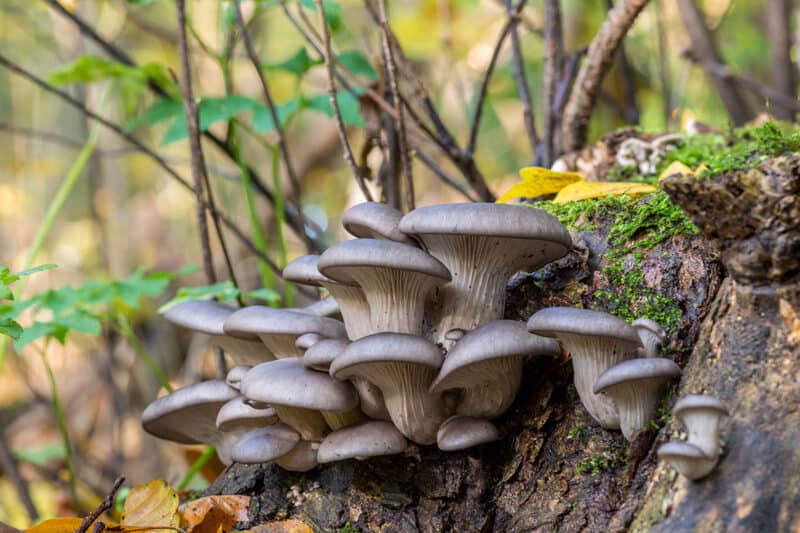
Here’s another mushroom variety that is easy for beginning foragers. Oyster mushrooms (Pleurotus ostreatus) tend to grow on wood, such as rotting logs or tree trunks. They range in color from white to pale brown or light pink.
The best way to identify oyster mushrooms is to look for pure white gills and a short, off-center stem. They also have a distinct growing pattern – growing in groups on dead or dying trees.
Oyster mushrooms have a longer growing season than other varieties as well. You can find these in the fall, spring, and winter, depending on your location.
4. Chicken of the Woods
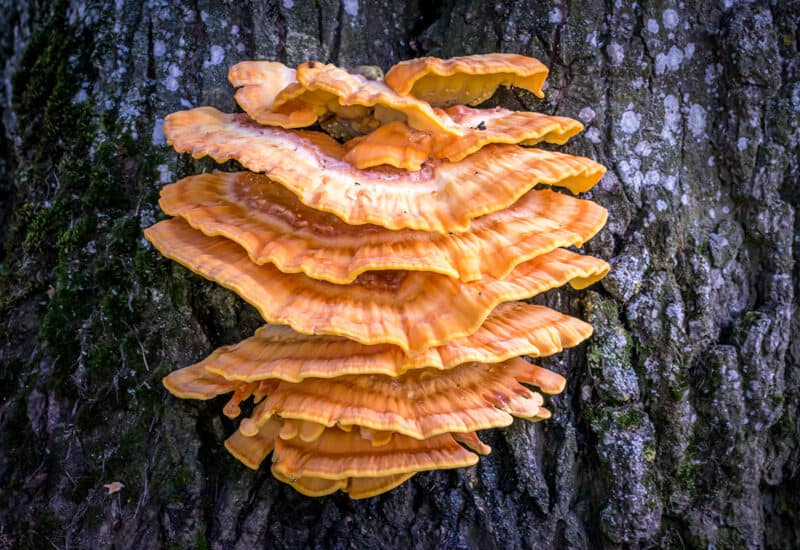
Everyone wants to find chicken of the woods (Laetiporus spp.) when mushroom foraging. Sometimes called sulfur shelf, they’re odd-looking fungi that taste like chicken, hence the name.
Chicken of the woods grows in tightly layered formation on trees, which makes it easy to find. You’ll also notice the bright orange-red color and lack of gills. Also, they typically grow in groups, so you should find plenty in one area.
5. Maitake Mushrooms
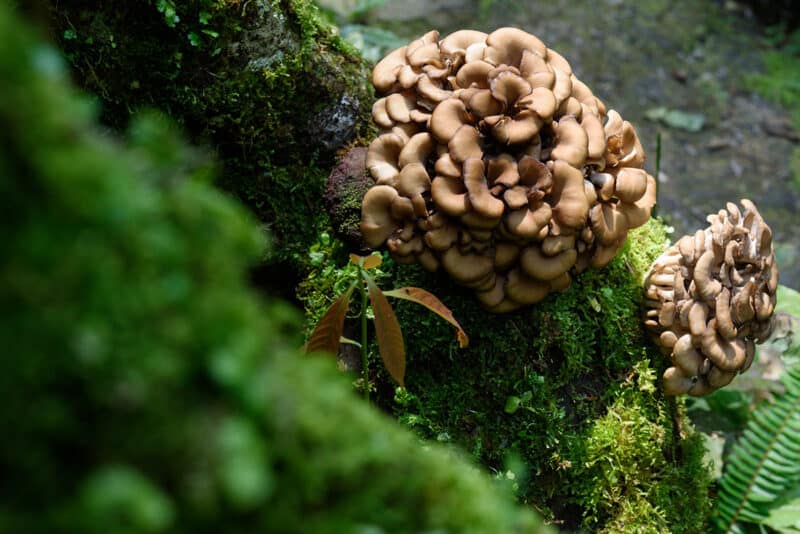
Many people refer to Maitake mushrooms (Grifola frondosa) as hen of the woods or ram’s head mushroom. No matter what it’s called, this type of foraged mushroom is highly coveted.
Maitake mushrooms originate in China, where many believe that they have medicinal properties. Once you find where they grow in your area, keep it a secret; they’ll pop up in the same spot each year.
Maitake mushrooms are easy to identify because they have overlapping, lacy fronds. They’re large and brownish-black with a firm texture.
6. Lobster Mushrooms
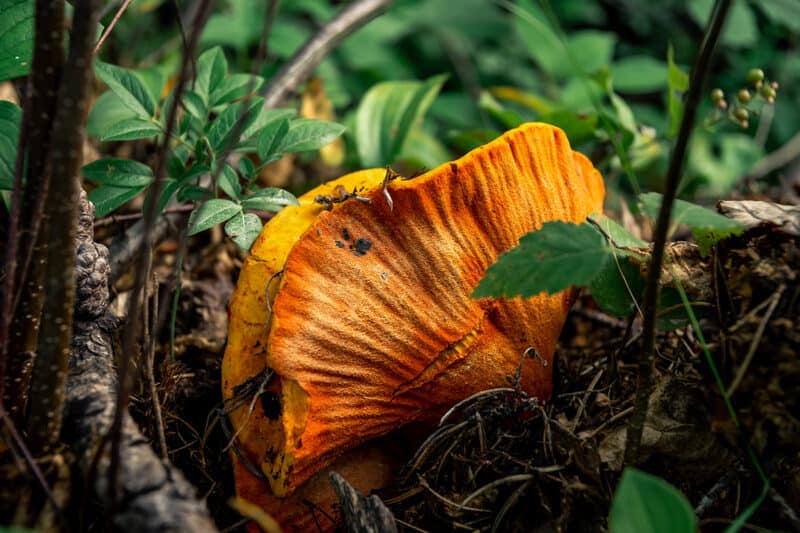
Technically, lobster mushrooms (Hypomyces lactifluorum) aren’t true mushrooms. Instead, they’re parasitic fungi that prey on other mushrooms, taking them over. They take the shape of the mushroom they attack, which means the shape of these mushrooms varies widely.
The easiest and most dependable way to identify lobster mushrooms is by their coloring. They have a bright red exterior and white interior, resembling a lobster.
7. Porcini Mushrooms
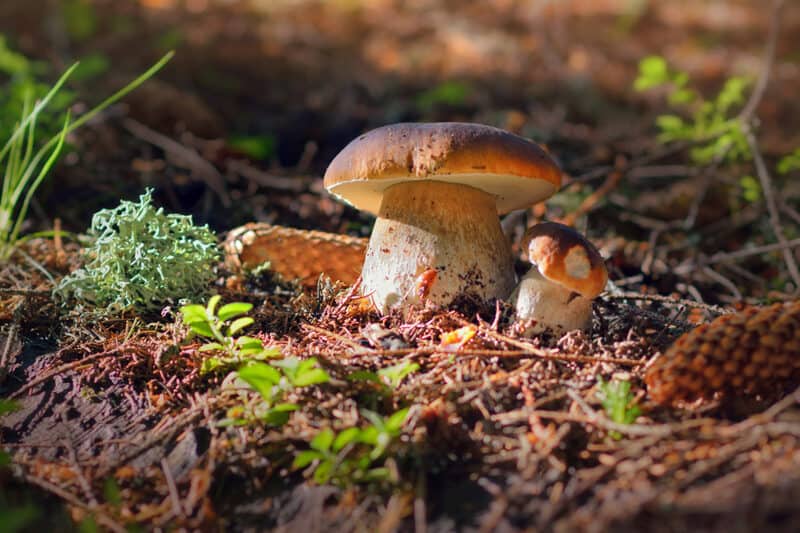
One of the hardest mushrooms to find and hardest to grow are the porcini mushrooms (Boletus edulis), but chefs love them because of their earthy, rich flavor and versatility.
The best way to identify porcini mushrooms is by their dark brown/reddish sticky cap and fat stem. They typically grow on the ground of hardwood forests.
Unfortunately, cultivating these mushrooms is rather difficult, so that means if you find them, they sell for high price tags. In stores, most porcini mushrooms are dried.
8. Lion’s Mane Mushrooms
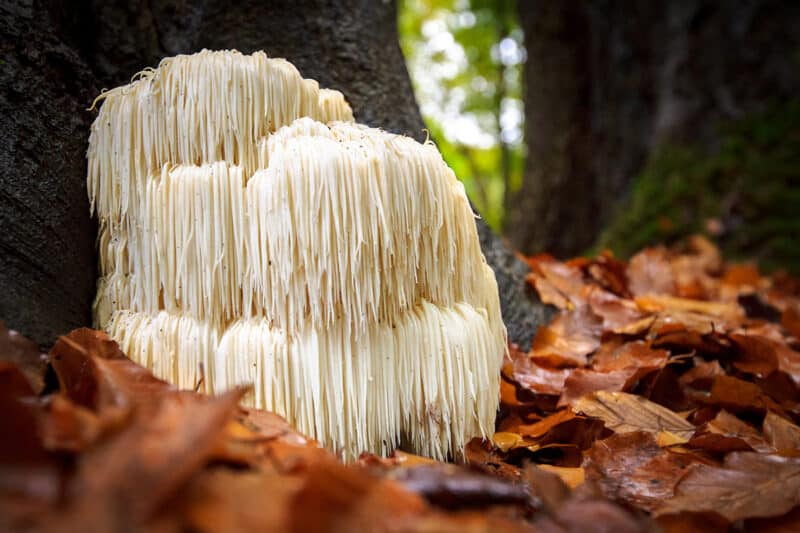
Without a doubt, one of the strangest looking types of mushrooms is the lion’s mane mushrooms (Hericium erinaceus). Instead of flashy caps and stems, this mushroom has tooth-like spikes that look like a waterfall, going down logs, stumps, and wherever they’re growing.
They’re sometimes these are called pom-pom mushrooms because they look like the pom-poms cheerleaders use. The great thing about foraging for lion’s mane mushrooms is that there are no look-a-likes and all forms are edible.
9. Pheasant Back
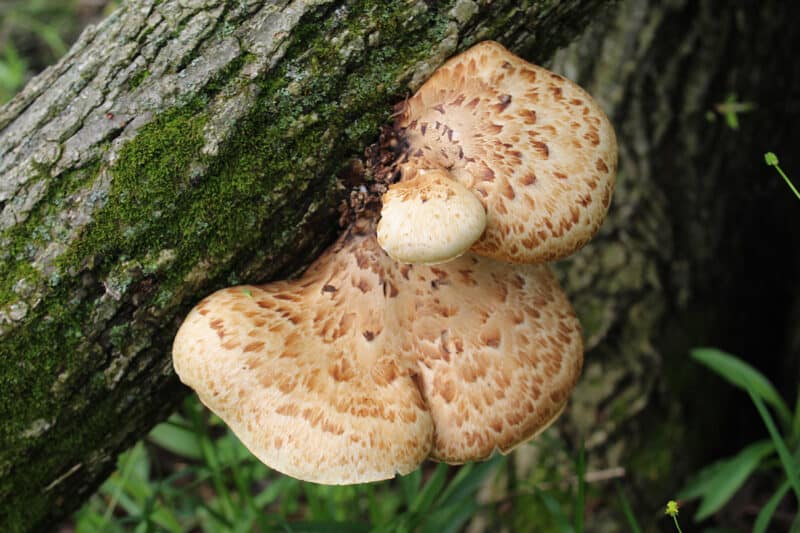
This is a common bracket fungus that grows in the Midwest from spring into early winter. Pheasant back (Cerioporus squamosus aka Polyporus squamosus) is easy to identify and has no poisonous look-a-likes, so it’s perfect for beginners at mushroom foraging.
Pheasant back mushrooms (also known as dyad saddle mushrooms) are always found growing from wood, typically hardwood. The tops have brown, feathery scales, and the underside has a pored, off-white surface.
They have no gills, and the base is hard with a black outer layer, especially if they’re older.
The best part and most identifiable marker of pheasant back mushrooms is the smell when cut open. These freshly cut mushrooms smell exactly like watermelon rind.
For best results in the kitchen, harvest when they’re young, preferably no larger than the palm of your hand. Older mushrooms need to be trimmed to remove the harder edges.
10. Shrimp of the Woods
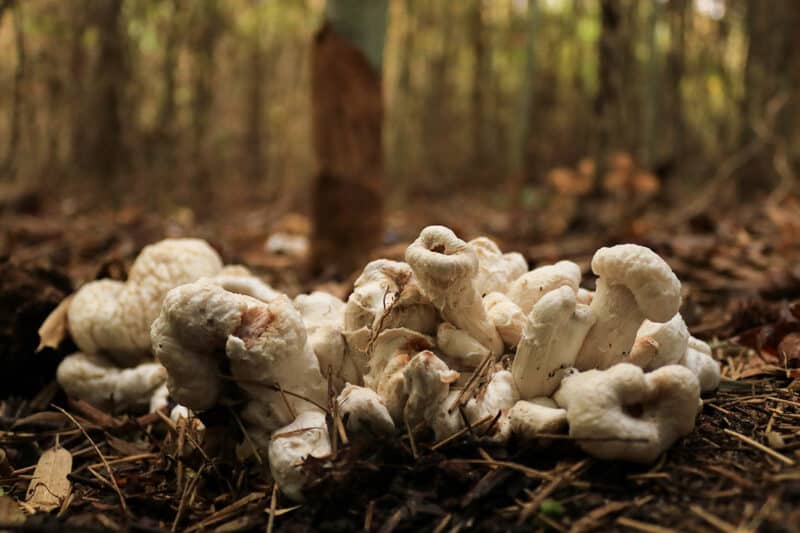
Here is another type of mushroom that works perfectly on the dinner table. Shrimp of the woods (Entoloma abortivum) appear in fleshy, fuzzy, popcorn-like clusters under rotten wood and along with dead, buried roots in deciduous woods throughout the fall.
The hardest part of foraging shrimp of the woods is that they are often covered in dirt, so you have to clean them well. A little dirt won’t kill you.
There aren’t any dangerous lookalike mushrooms, so these are great for beginners. When cooked, they have a mild flavor and seafood-like texture.
11. Cauliflower Mushroom
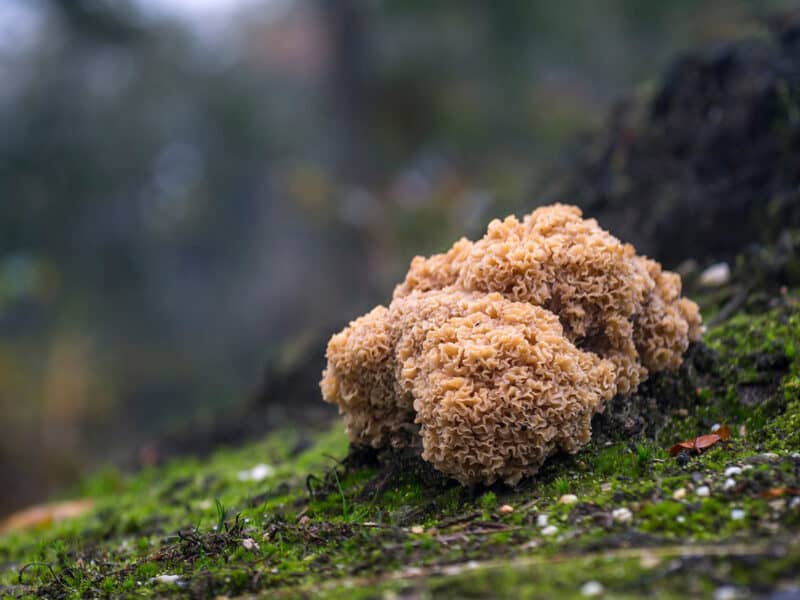
Cauliflower mushrooms (Sparassis spathulata, Sparassis americana) aren’t easy to find, but they’re incredibly simple to identify and they don’t have any poisonous lookalikes.
They’re another parasitic type and tend to grow at the base of dying or next to dead trees. Young mushrooms are about six inches in diameter, but I know people who have found ones that were 18 inches.
They look somewhat like a creamy brain or giant head of cauliflower. The most accurate description I’ve ever heard is that they look like a huge pile of egg noodles balled up on the ground.
There are no gills or teeth on this mushroom, and the ribbons are smooth and folded.
Cut them off at the ground level, but don’t disturb the roots. They’ll return year after year, so mark the location. They require a lot of rinsing to get all of the dirt out of the folds.
The flavor is somewhat nutty and earthy with lots of umami. The texture is firm and chewy.
A Warning
I’m sure you’ve heard it before, but never, ever, ever eat a mushroom that you haven’t positively identified. Beyond online resources, you can check with local extension offices and experts to ensure the mushroom you’ve found is edible.
It’s a potentially deadly mistake to eat the wrong mushroom, so always consult with an expert. While this guide will get you on the way to foraging for these delicacies, it should only be used as a starting point for your adventures.
